
We’ve all been baited into those lists of recycled tips where the author lists 10,000 excruciating content creation tips, all of which you’ve heard over and over again.
I’m pretty sick of it, so thought I’d compile something from my personal experience from a year of writing.
This is stuff I’ve had to learn pretty quick since I ‘fell into’ control of the Process Street blog. I think it’s time to give the marketing community something new that they can use and ditch the typical list post content we’ve all seen trotted out over and over.
Whichever part of the content creation process you’re at, there’s a nugget of wisdom for you here.
Let’s get started.
Idea Generation Techniques

Writing can be a real pain, especially since it’s a creative pursuit and a profession. You can’t always come up with enough ideas to fill the content calendar, and that’s because you’re a real human being with an actual brain, not a content machine.
Here are some tricks I use every couple of weeks to fill the calendar with ideas.
Use Quora to find gaps in the content landscape
If you’re stuck for content ideas, there aren’t many publicly available databases of burning issues out there better than Quora.
If someone’s asking a question on Quora, it’s usually because there wasn’t the content out there to guide them. And if it doesn’t exist, it’s time to make it.

I’ve written before about 5 ways to use Quora for content marketing, but I’ll give you a quick overview now.
- Search your niche in Quora
- Click the ‘topic’ option in the dropdown
- Find questions and keywords that your target market is looking for.
Create a mind map of related subjects
At Process Street, we don’t write about processes all the time. Instead, we address things that people who use processes might be interested in. By looking at our data, and areas our customers might be interested in, we figured out a list of topics (like productivity, marketing, SaaS, and business) which would be interesting to our audience.
A way to visualize this is using a mind mapping tool like Mindmup. Imagine you’re writing about gold panning, for a moment. With a few spare minutes, Google, reddit, and Quora, I was able to create a pretty big list of related topics:
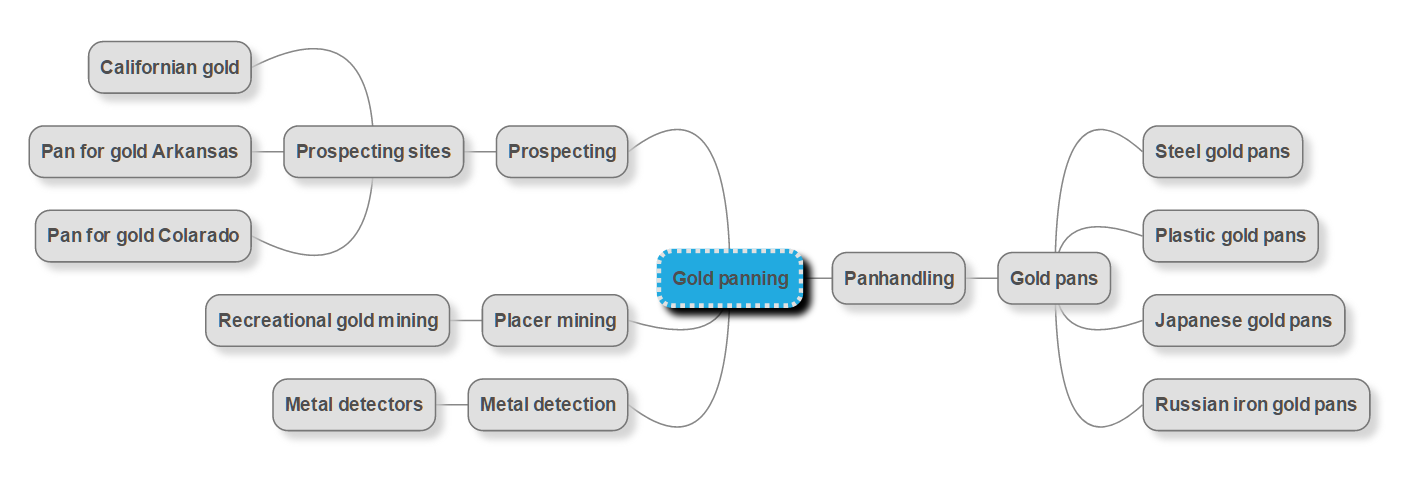
Automatically create a database of ideas that updates while you’re away
Around 6 months ago I set up a system that grabbed every trending post from Reddit’s Entrepreneur subreddit and added it to a spreadsheet.
When I go back to that today, it has over 4000 rows, each of which containing questions and topics that entrepreneurs care about.
How do you set up a system like this? I did it using IFTTT. You can use the recipe below (and substitute out ‘productivity’ with anything you like to do the same.
The sooner you do it, the bigger the database you’ll have.
Get in touch with the experts to write a definitive guide
Last week I published a guide that was the result of interviewing 14 SaaS companies on the customer success process. The notes from the interview were HUGE. I got over 10,000 words of material from the companies I reached out to which I condensed down to just under 3,000, condensing advice from people who really know their stuff.
To find the companies I wanted to interview, I put together a short list of companies I wanted to speak to, but then just grabbed a database an assistant collated by scraping contact details from AngelList and send the template out to them all using Close.io.
Here’s the email I used:
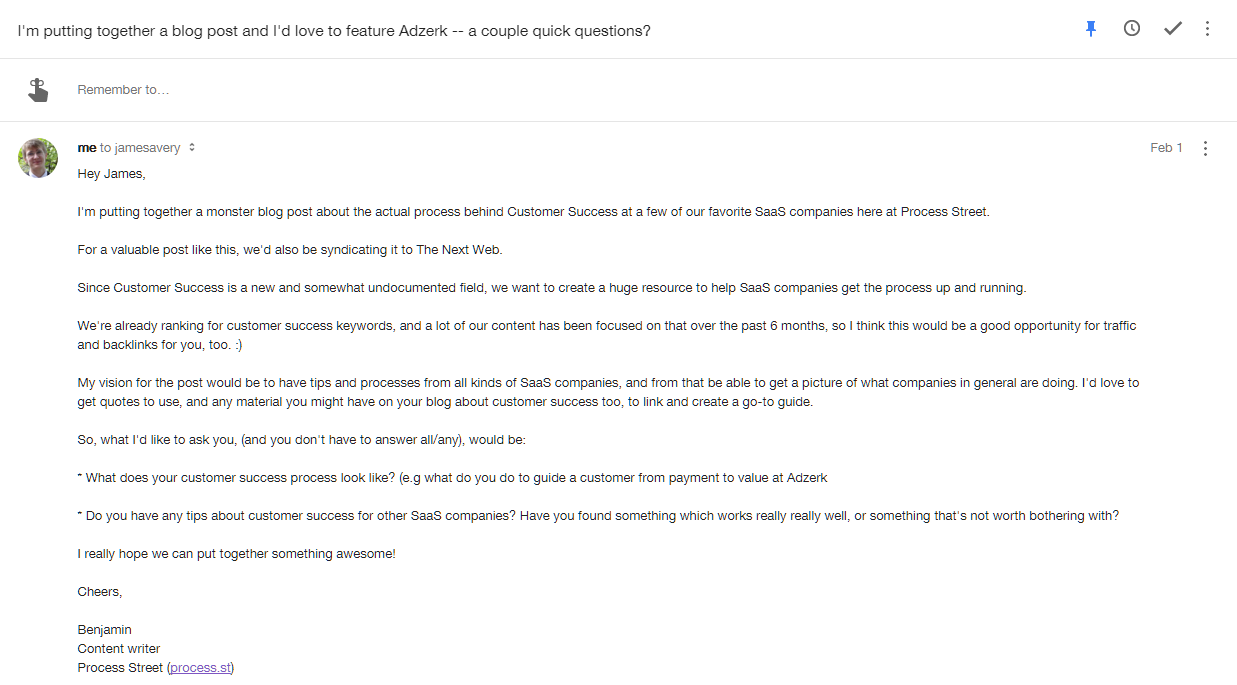
I sent emails out to 73 SaaS companies and got full responses from 14 of them. A 19% reply rate is pretty good, I’d say.
Techniques for efficient writing and note-taking

Once you’ve got an idea, it’s time to actually write it. A lot of writers struggle with where to start, but once you’ve got an idea you can easily make notes and not worry about how messy it all is until much, much later.
Take notes with WorkFlowy
Seriously, there’s nothing better for roughing out a draft or taking notes than WorkFlowy.
Let me show you a quick recording of my notes from a recent blog post:
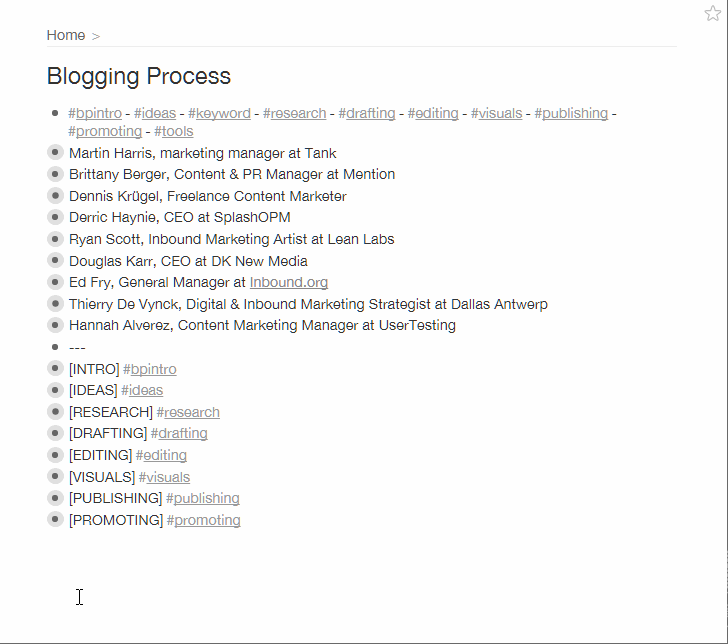
The way I do it is to take my source material (in this case it was comments on a thread on Inbound.org) and break it down into key points. Then, I synthesize a structure from these key points and make a bullet point for each subheading and an accompanying tag (#intro, for example).
When I go into the tag, I zoom to the section where I can make notes inside the subheading and have all my previous notes tagged and visible.
Use Evernote tags to organize your blog posts
We’ve already covered how Evernote can improve your writing workflow, The way I structure my Evernote is like this:
- Work:
- Inbox
- Swipe File
- Blog Posts
In the Blog Posts notebook, I organize research and outlines with tags because then sources can exist in two places at once, not confined to a notebook.
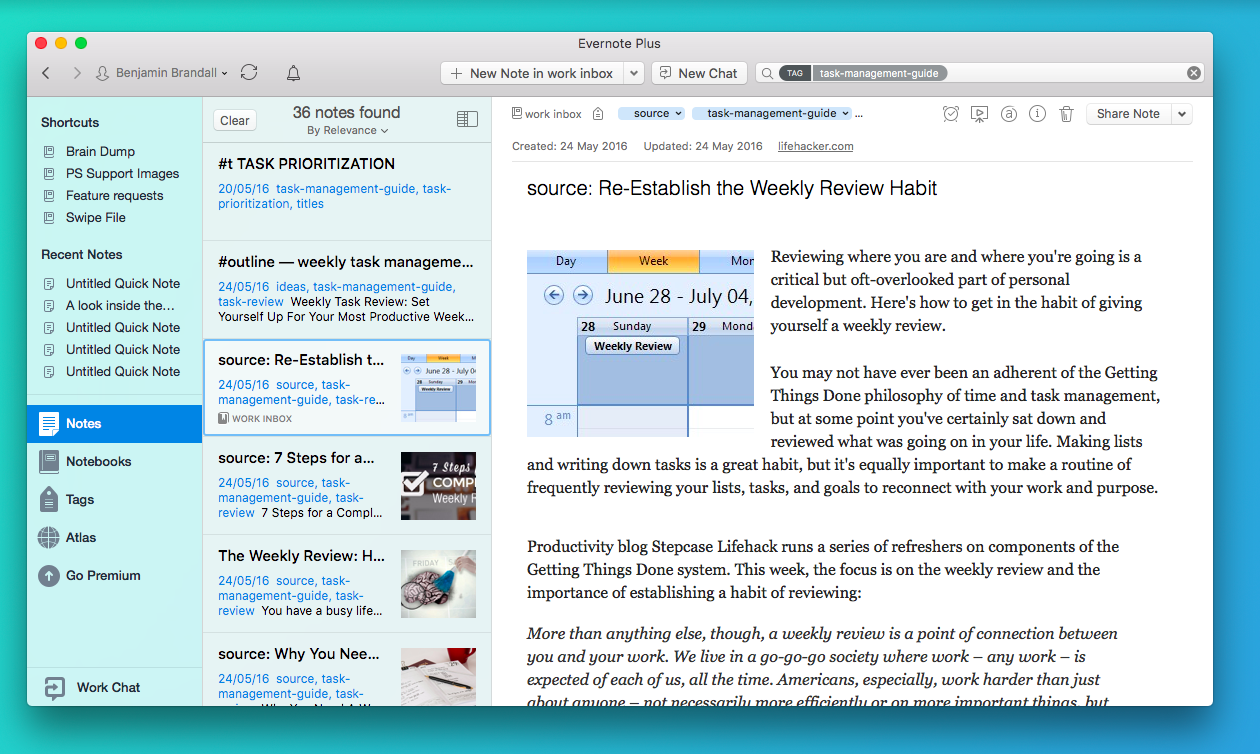
My Inbox is the default place for my clippings and new notes, and I organize notes here into their correct tags every Wednesday.
My swipe file (more on that later), is where I forward emails and organize clippings of great copy that I can look over later and learn from.
Use Pocket (and integrations) to save your research
For long research sessions where you don’t want to interrupt your content creation process too much by switching between applications, try saving articles to Pocket with a unique tag representing the project you’re working on.

To save an article to Pocket without clicking, use Command+Shift+P (Mac) or Control+Shift+S (Windows), then type your tag and hit Enter.
Keep a swipe file of great writing examples you can refer to at any time
While it’s not 100% the same thing, copywriting and content writing has some definite similarities, mostly in the headlines and openings that draw readers further down the page. Whenever you find content that compels you to click and keep reading, grab a screenshot or link using the Evernote Web Clipper and save it to your swipe file.
Another way to fill your swipe file, as I mentioned earlier, is to forward emails straight to your Evernote. Create a notebook called Swipe File then append @Swipe File to the end of the subject lines that you forward to your unique Evernote address.
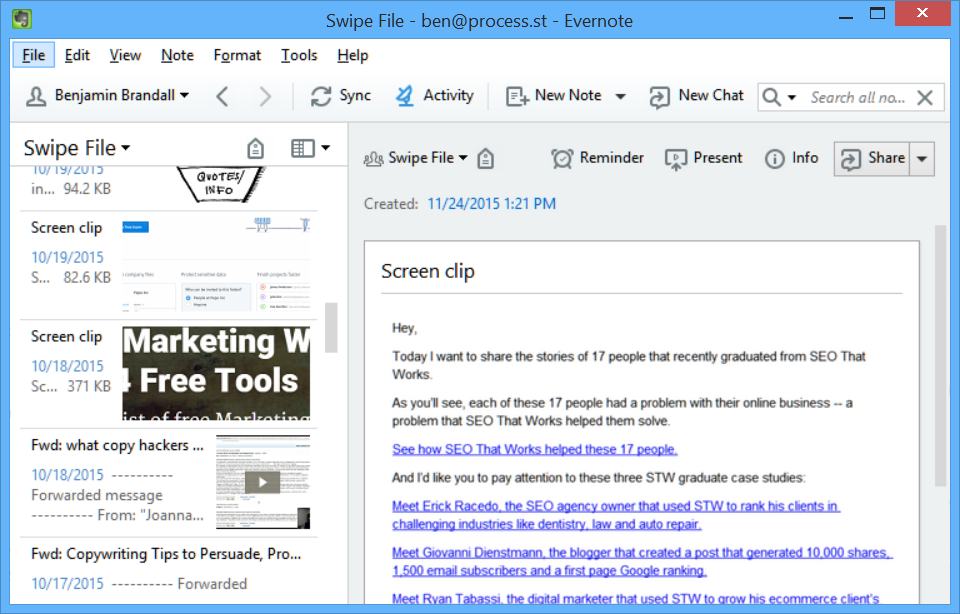
At the moment, I only have around 100 copywriting examples in my swipe file, most of which are emails and clips of headlines and landing page copy. If you want to see it, let me know in the comments and I’ll share it with you.
Use a checklist to write high-converting headlines at record speed
In line with a piece of advice I heard on the Asian Efficiency podcast’s episode on simple systems, if I have to do something more than 3 times, I’ll make a system for it.
Since I write headlines more than 3 times every week, I’ve created a quick checklist for the process to speed things up and make sure I’m not writing a load of rubbish.
- Check over formulas for the most famous headlines ever written
- Sell the benefits, not the features
- Accurately describe what you’re writing about
- Keep your reader’s objections in mind (and fight against them)
- Include power words if you can
- Cut it to between 5-18 words
- Use a number, fact, percentage or statistic
- Make your headline extremely specific
- Redraft it until you’re sick of it, then do it again
See the headline checklist in full, plus a lot more explanation, here.
Techniques for Editing

Bad editing can be the death of good content. While writers furiously bash their words out because over-thinking means stopping the flow, editing needs to be in place to make sure the words being written are true, readable and well-structured.
Recently, I put together a complete editing checklist, but here are some extra tips.
The Traffic Light Method
Sometimes it’s really easy to get lost in your own work and lose sight of whether what you’re writing is good or not. In times like these, I’m not adverse to throwing the whole lot in a Google Doc and using the Traffic-Light Revision Technique.
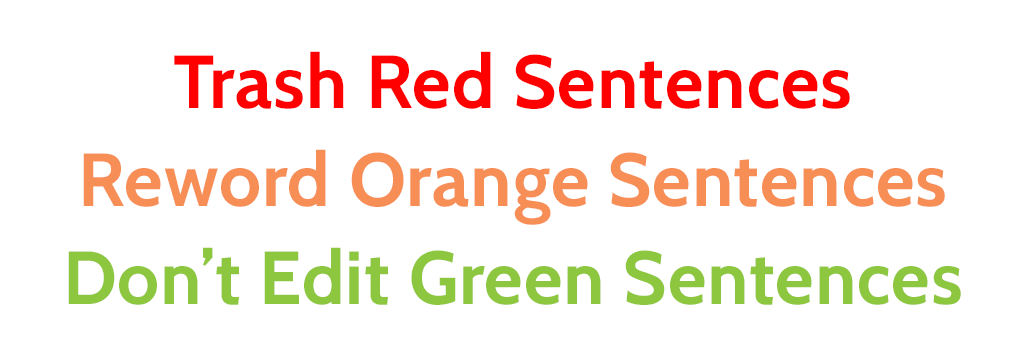
What this means is that you mark sentences in green, orange or red depending on how much editing they need:
Green: Fantastic sentence. Needs no editing
Orange: Slightly awkward. Needs a bit of rewording.
Red: Trash. Needs removing or severe editing.
Edit in markdown using a collaborative platform like Beegit.
I’m doing this right now!
A little time spent learning markdown saves you a heap of time clicking around the WordPress editor or formatting Google Docs into HTML.
It’s only recently that I’ve made the switch, but the WordPress editor was always one of my least favorite places to write so thanks to Zapier’s article on the power of markdown I found my perfect writing environment.
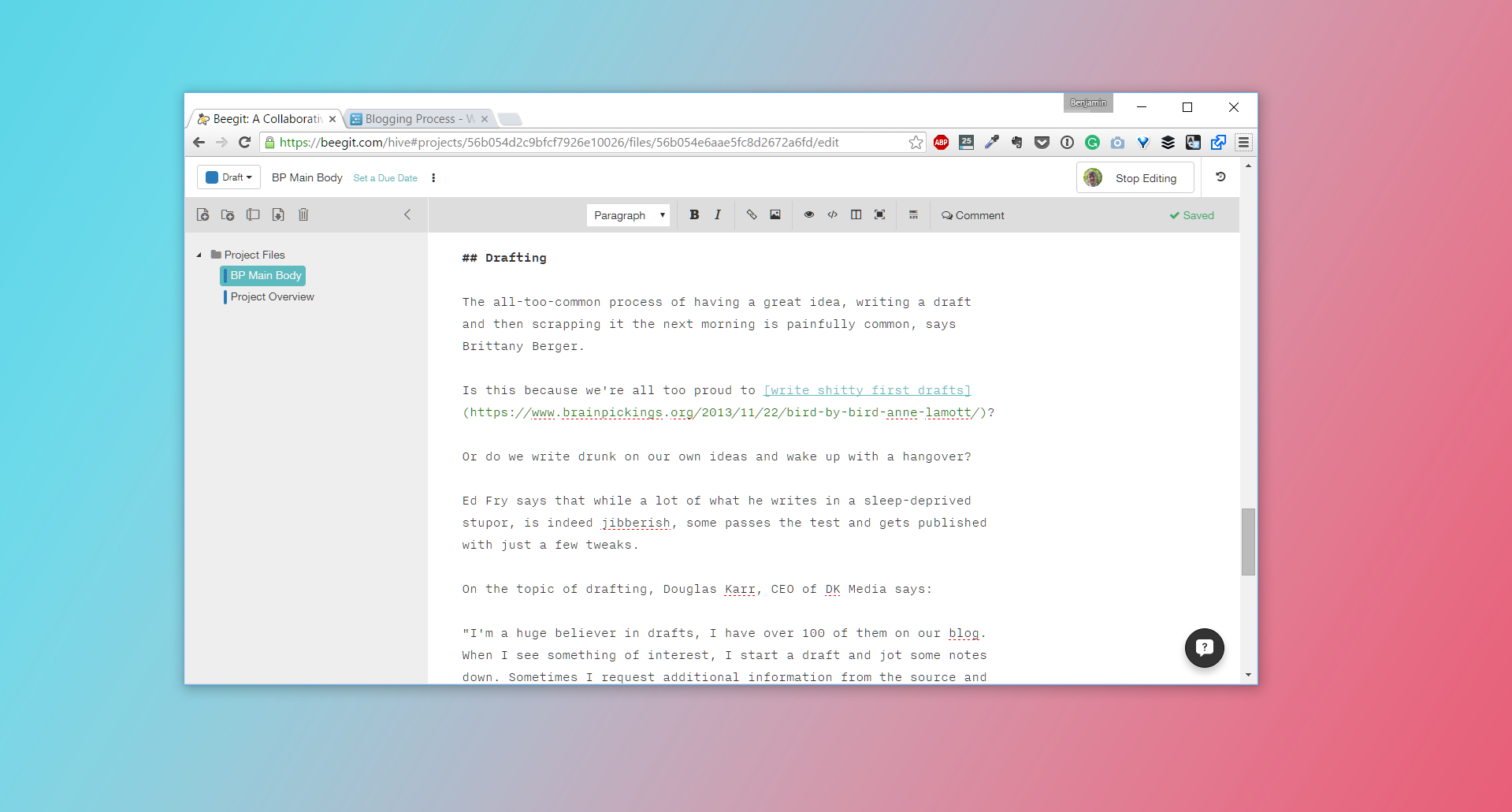
If you write in a team or use the help of an editor (and you all love a bit of markdown), Beegit is built for that and offers an easy way to collaborate. Personally, I write and edit my own stuff, but I can see how powerful it’d be.
Use a checklist to quickly edit your blog posts (without mistakes)
Don’t delete anything until the final draft
Here’s a tip I picked up from Scott Berkun’s short talk about avoiding writer’s block.
If you haven’t seen it, it’s well worth a watch just to see time-lapse footage of a writer’s process.
The idea is that we can easily get attached to sentences which don’t fit in with the article.
Scott suggests writing with a divider at the bottom the page where you put your sentences condemned to sad deletion. This is good because you might find a way to work it in later, and also you won’t hesitate so much when killing your darlings.
Check your style in the Hemingway Editor
Would Ernest approve? Answer that question by pasting your content into the Hemingway Editor:
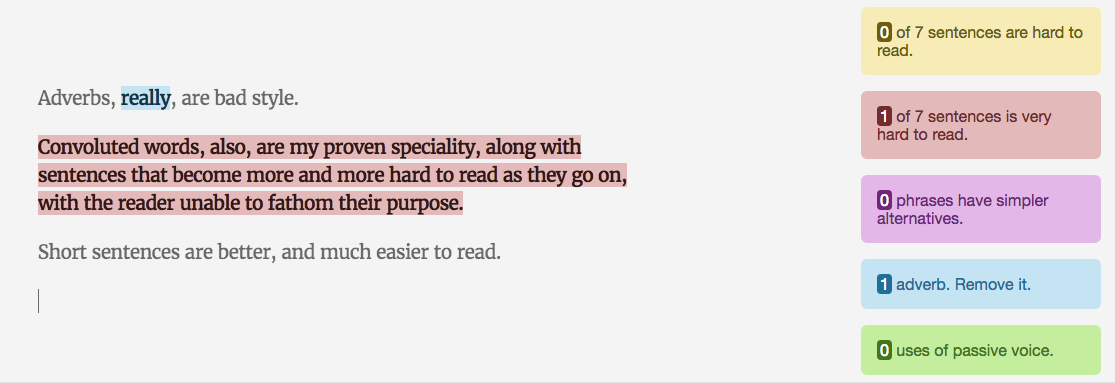
While I don’t use this as often as I should, sometimes there are those situations where you can’t tell why a sentence sounds awkward.
SEO: How to Make Sure Your Blog Posts Get Seen

SEO is a huuuge topic. It’s optimizing your posts so Google understands the topic, researching the right target keyword, getting links back to your article, and more. Thankfully, a lot of what’s involved in ranking for great keywords can be boiled down to a few repeatable processes.
Use a checklist to get the perfect keyword every time
The first stage of optimizing a post for SEO and making sure it ranks is picking the right keyword. But “what’s the right keyword?” you may ask. Well, good keywords will have a few of these 3 elements:
- Highly targeted and relevant to your product or service (like Process Street ranking for workflow automation)
- High volume (plenty of people search this keyword every month)
- Low difficulty (other content ranking is poor or from low-quality domains)
But it isn’t always black and white. That’s why we use a keyword research process to find low-hanging fruit relevant to our blog.
Keyword optimizing your blog content
I was going to write my own section here about on-page optimization, but naturally the SEO big cheese Brian Dean beat me to it with his amazing infographic.

How to rank for the world’s most boring keywords
People like to share things about hot new apps, design, startup scandals and Twitter feuds. They don’t much care for dry (but extremely useful) topics that are super-relevant to our product.
People Google for boring keywords all day, but you don’t often see it floating around your social media or on highly-trafficked news sites. At Process Street, we’ve been aiming to rank for the keyword ‘employee onboarding‘ because it’s one of our tool’s best use cases.
Instead of looking for HR blogs and pitching them stories about onboarding, we took a broader look and targeted everywhere that has written a well-received article about remote work, and pitched them more of the same. In the body of the article, we always included a link back to the not-so-exciting article about employee onboarding.
Using that tactic, we’ve rocketed up the rankings for long-tail variants and are well on our way to rank for the sought-after ’employee onboarding’.
What have you learned?
I’ve been in content marketing for a year now. Looking back at my old posts, I know I’ve learned a hell of a lot in these 157 posts.
You’ve probably been doing this longer than I have, so I’d really love to know some of the best lessons you’ve learned, too.
Let me know in the comments.







 Workflows
Workflows Projects
Projects Data Sets
Data Sets Forms
Forms Pages
Pages Automations
Automations Analytics
Analytics Apps
Apps Integrations
Integrations
 Property management
Property management
 Human resources
Human resources
 Customer management
Customer management
 Information technology
Information technology



Benjamin Brandall
Benjamin Brandall is a content marketer at Process Street.